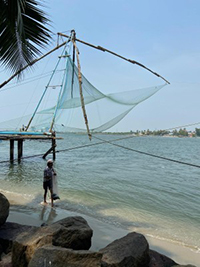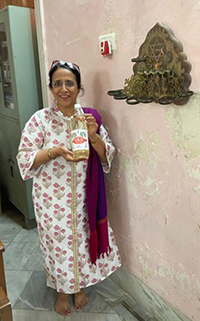By David Mendelsohn

The large number of Jews travelling to India in an effort to gain wisdom also irked me. Because I believed – and still do- that the answers to much of the wisdom they sought can be found in the wisdom of our own sages as written in many of the Jewish scriptures. Yet eventually I began to ask myself a related question – why are there so many similar if not identical questions? Why is there so much wisdom and so many answers to be found in India?
A book that I purchased in India by Devdutt Pattanaik: Olympus: an Indian Retelling of Greek Myths, helps address this point – The very idea that in another part of our globe, self-aware, intelligent people examine Greek mythology from their own world view seems surprising – perhaps even quaint. Ultimately it is humbling to meet and converse with a curious and questing intelligence originating from a totally different global and cultural perspective.
And much of the wisdom and knowledge imparted by our wise ancestors was gained by living among and interacting with wise and knowledgeable philosophers of other civilizations be they Babylonian, Greek or European. Why should our repository of knowledge end in a corked bottle rather than continue to be filled in an open well?
Now I strongly recommend traveling to India and the sooner the better. Go for the colors, taste the flavors and visit India to experience another worldview and new perceptions of our human universe very different from that of the West. Go for the Jewish experience.
Stroll down a street in India and you smell our history – cardamon, nutmeg, cinnamon, cumin and saffron – these are essences of the spice trade that tempted merchants and traders to undertake the long voyage, by sea and land.
Hire a rickshaw and, as you are pedaled to your destination open your eyes to the vibrant colors on the buildings, cars, trucks and worn on the saris of the women. Even an elephant swaying down the road will often be brightly painted and covered with multi-hued illustrations of gods and symbols of good luck.
Into this colorful soup, so full of flavors and rich scents arrived the Jews. And they lived in India for thousands of years in some cases. They became part of the culture, spoke the local language adopted the customs, and remained Jewish.
The glorious chaos of colors, gods, temples mingling with the chimes and chanting and the smells of incense, spices become more organized and manageable when exploring them through a Jewish lens – an Indian Jewish lens.
Let’s begin our own journey in the southwest coast with the Jews of Cochin.
The origin story of the Cochin Jews begins with ancestors who were commissioned in Jerusalem by King Solomon to set up trade colonies in what is now the state of Kerala where they flourished for many centuries as a respected caste under the local rulers. This close relationship is actually codified on a set of copper plates (inscribed with the date 379 CE) granting the community special privileges.
The Hindu king granted the Jews permission to live in Cochin in perpetuity “as long as the world, sun and moon endure” to live freely, build synagogues, and own property.”
Other Jews of Cochin claim they arrived as exiles, following the destruction of the First Temple in the Siege of Jerusalem (587 BCE). In fact, records as early as 70 CE attest to numerous Jewish settlers arriving at a port near Cochin.

From Cochin we move to the Western coast to encounter and converse with the Marathi-speaking Bene Israel who have lived in the villages and towns of the Konkan coast for generations upon generations. The Bene Israel narrative begins with seven couples shipwrecked off the Konkan coast at Navgaon, just south of Mumbai over 2,200 years ago, when Jews faced persecution by the Seleucids in Jerusalem.

[Photo: David Mendelsohn]
Throughout their history, despite their isolation, the Bene Israel Jews followed the dietary laws, observed the Sabbath and holidays such as Rosh Hashanah, Yom Kippur, and Simchat Torah.
In 1947, the Bene Israel of Mumbai numbered around 24,000. Due to an immigration rush to Israel and to the UK, the population has now dwindled to a couple of thousand.
Their cuisine is influenced by the cooking of the local Maharashtra people. We have the familiar coconut milk, chili, cardamom, cinnamon, turmeric, ginger, cumin, coriander and garam masala adapted to Jewish kosher dietary laws, and unique customs of the Bene Israel Jewish community.
In the 18th century, Jews from Baghdad began to settle in Mumbai. They built a thriving Jewish community, adding their culture and customs to the local Indian Jewish landscape.
In 1833, David Sassoon arrived in Bombay from Baghdad. It was a good fit. The Sassoons rapidly established a successful financial empire (with centers in Bombay, Calcutta, Rangoon, Hong Kong, Shanghai, Singapore, and elsewhere). These successful enterprises, along with their wide-ranging charitable activities, earned them the title of the Rothschilds of India.
Like the Bene Israel and Cochin Jews, the Baghdadi Jews in India did not have ordained rabbis of their own. They followed the Baghdad Jewish traditions and obeyed the rulings of Baghdad’s Jewish sages on questions of ritual and law. Cultural customs such as circumcision rituals, betrothals, marriage and funeral customs remained Baghdadi rather than fusing with local Indian traditions. Even today, despite a shrinking population, their cuisine retains its Middle Eastern flavor.
These three communities all have a unique role and native status within Indian society. The Bene Israel, Cochin and even Baghdadi Jews are fully Indian as they are fully Jewish. When we explore India together it is with a sense of belonging rather than as merely tourists. And that makes all the difference.
*
Professor David Mendelsohn’s areas of expertise include Islamic Studies, History and Culture of Arabs with Israeli Citizenship, Bedouin Law and the relationship between language and culture in Arabic and Hebrew. He will be leading a trip to India with Ayelet Tours this coming November – www.ayelet.com.
Absolutely, travel to India. Jewish history is diverse, rich, and now almost vanished from the Sub-Continent.
The good professor spent a lot of time on culinary Judaism in the article. A few questions were glossed over.
The dates of the copper plates are controversial. The most accurate date for documented Jewish life is about the 9th century. Indian Jewish traditions (plural because the many diverse Jewish communities do not agree with each other) established their own narratives and even myths.
In Cochin, the one, somewhat functioning, but mainly tourist-attracting synagogue is the Paradesi. The word Paradesi does not mean Paradise. It means “Foreigner.” The Paradesi Jews were largely Spanish- Portugese Jewish refugees from the Inquisition, arriving in the 17th century. The Paradesi and the local Jews, the Malabari, did not get along. One would not let the other into their own shuls because of Minhag, social, and yes, racial tensions. The brown tones Spanish-Portugese Jews were considered White and they considered the darker skinned native Jews as Black. OYE!
Why did the Jews suddenly head out of town after living in India for “two thousand” years when the State of Israel was established? What changed? It wasn’t just a deep desire for Jerusalem-made hummus.
Jews have a long, long history in Pakistan and Afghanistan, too. Jews are not welcome in Pakistan and Afghanistan whenever fundamental Islam is reigning. It is not healthy to be a Jew there today.
Jews are welcome in India. India has a rich, rich Jewish past. Go East and Discover!